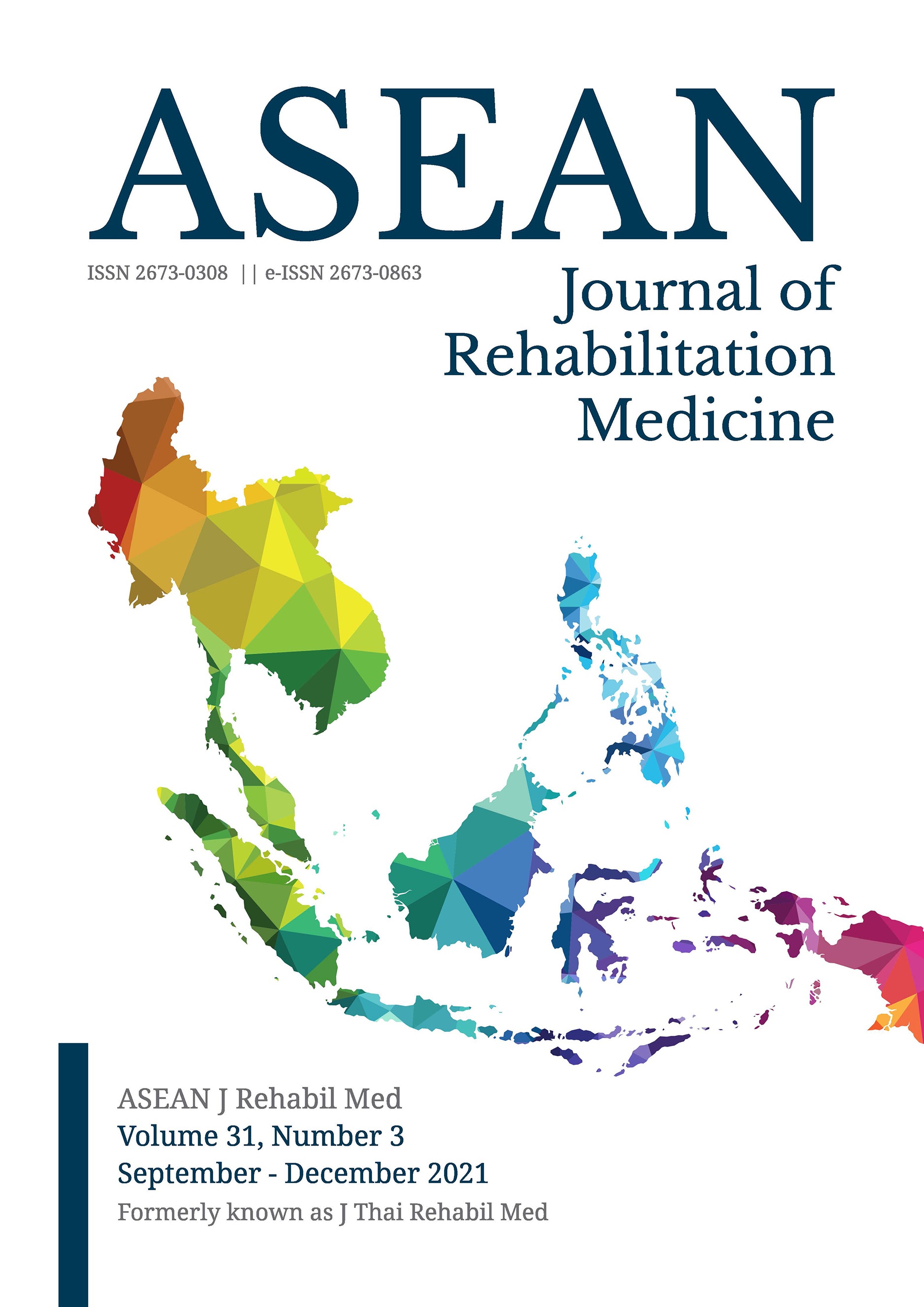Suprascapular Nerve Block versus Intra-articular Steroid Injection for Hemiplegic Shoulder Pain: A Preliminary Double-Blind Randomized Controlled Trial
Keywords:
hemiplegia, shoulder pain, stroke, scapular nerve block, intra-articular steroid injectionAbstract
Objectives: To compare the analgesic efficacy of two alternative injections in improving passive shoulder range of motion and shoulder function in patients with hemiplegic shoulder pain.
Study design: A double-blind randomized controlled trial.
Setting: Rehabilitation Medicine Clinic, University Malaya Medical Centre, Kuala Lumpur, Malaysia.
Subjects: Patients with hemiplegic shoulder pain of at least two weeks duration were recruited into this study
Methods: Either a suprascapular nerve block or an intra-articular steroid injection were administered to all patients. Maximal tolerable passive range of motion and the corresponding numerical rating scale pain score were documented at pre-injection and at one hour, one month and three months post-injection. The Shoulder Pain and Disability Index questionnaire was completed by the participants at pre-injection and at one month and three months post-injection. All outcome measures were analysed using repeated measures ANOVA.
Results: Thirty-one patients were enrolled in this study. The mean age was 57.7 years (SD 8.1). Mean stroke duration was 16.9 months (SD 24.2). Twenty-six of the strokes (83.9%) were of ischaemic aetiology. Significant pain reduction, passive range of motion and shoulder pain and disability index over time were evaluated in both groups. The intra-articular steroid group had an analgesic effect earlier (at one month) than the suprascapular nerve block group (at three months). No significant differences in pain, shoulder passive range of motion or shoulder pain and disability index between the two groups were observed at any point in this study.
Conclusions: Neither injection technique was found to be superior in terms of pain reduction, passive range of motion increase or reduction in Shoulder Pain and Disability Index score. However, this result could be due to the small sample size. The intra-articu-lar steroid group evidenced an analgesic effect at one month, earlier than the suprascapular nerve block group.
Keywords: hemiplegia, shoulder pain, stroke, scapular nerve block, intra-articular steroid injection
References
Turner-Stokes L, Jackson D. Shoulder pain after stroke: a review of the evidence base to inform the development of an integrated care pathway. Clin Rehabil. 2002;16:276-98.
Poduri KR. Shoulder pain in stroke patients and its effects on rehabilitation. J Stroke Cerebrovasc Dis. 1993;3:261-6.
Ryerson S, Levit K. Physical therapy of the shoulder. 3rd ed. New York: Churchill Livingstone; 1997.
Viana R, Pereira S, Mehta S, Miller T, Teasell R. Evidence for therapeutic interventions for hemiplegic shoulder pain during the chronic stage of stroke: a review. Top Stroke Rehabil. 2012;19: 514-22.
Wiener J, Cotoi A, Viana R. Chapter 11: Hemiplegic shoulder pain and complex regional pain syndrome. The stroke rehabilitation evidence-based review: 18th edition (www. ebrsr.com). Canadian Stroke Network. 2018.
Snels IA, Dekker JH, Van Der Lee JH, Lankhorst GJ, Beckerman H, Bouter LM. Treating patients with hemiplegic shoulder pain. Am J Phys Med Rehabil. 2002;81:150-60.
Adey-Wakeling Z, Liu E, Crotty M, Leyden J, Kleinig T, Anderson CS, Newbury J. Hemiplegic shoulder pain reduces quality of life after acute stroke: a prospective population-based study. Am J Phys Med Rehabil. 2016;95:758-63.
Yasar E, Vural D, Safaz I, Balaban B, Yilmaz B, Goktepe AS, Alaca R. Which treatment approach is better for hemiplegic shoulder pain in stroke patients: intra-articular steroid or suprascapular nerve block? A randomized controlled trial. Clin Rehabil. 2011;25:60-8.
Jeon WH, Park GW, Jeong HJ, Sim YJ. The comparison of effects of suprascapular nerve block, intra-articular steroid injection, and a combination therapy on hemiplegic shoulder pain: pilot study. Ann Rehabil Med. 2014;38:167-73.
Salaffi F, Stancati A, Silvestri CA, Ciapetti A, Grassi W. Minimal clinically important changes in chronic musculoskeletal pain intensity measured on a numerical rating scale. Eur J Pain. 2004;8:283-91.
Doğun A, Karabay İ, Hatipoğlu C, Őzgirgin N. Ultrasound and magnetic resonance findings and correlation in hemiplegic patients with shoulder pain. Top Stroke Rehabil. 2014;21:S1-7.
Wilson RD, Chae J. Hemiplegic shoulder pain. Phys Med Rehabil Clin N Am. 2015;26:641-55.
Kellgren JH, Samuel EP. The sensitivity and innervation of the articular capsule. J Bone Joint Surg. 1950;4:193–205
McMahon SB, Koltzenburg M. Wall and Melzack’s textbook of pain. 6th ed. Philadelphia: Elsevier Saunder; 2013.
Sidhu G, Preuss C. Triamcinolone [Internet]. Ncbi.nlm.nih.gov. 2020 [cited 2020 November 3 ]. Available from: https://www.ncbi.nlm.nih.gov/books/NBK544309/?report=classic
Triamcinolone [Internet]. Pubchem.ncbi.nlm.nih.gov. 2021 [cited 2021 August 7]. Available from: https://pubchem.ncbi.nlm.nih.gov/compound/Triamcinolone
Romundstad L, Breivik H, Niemi G, Helle A, Stubhaug A. Methylprednisolone intravenously 1 day after surgery has sustained analgesic and opioid-sparing effects. Acta Anaesthesiol Scand. 2004;48:1223-31.
Marx RG, Malizia RW, Kenter K, Wickiewicz TL, Hannafin JA. Intra-articular corticosteroid injection for the treatment of idiopathic adhesive capsulitis of the shoulder. HSS J. 2007;3:202-7.
Bupivacaine [Internet]. Pubchem.ncbi.nlm.nih.gov. 2021 [cited 2021 August 7]. Available from: https://pubchem.ncbi.nlm.nih.gov/compound/2474
Shanahan EM, Ahern M, Smith M, Wetherall M, Bresnihan B, FitzGerald O. Suprascapular nerve block (using bupivacaine and methylprednisolone acetate) in chronic shoulder pain. Ann Rheum Dis. 2003;62:400-6.
Gado K, Emery P. Modified suprascapular nerve block with bupivacaine alone effectively controls chronic shoulder pain in patients with rheumatoid arthritis. Ann Rheum Dis. 1993;52:215-8.
Lewis RN. The use of combined suprascapular and circumflex (articular branches) nerve blocks in the management of chronic arthritis of the shoulder joint. Eur J Anaesthesiol.1999;16:37-41.
Woolf CJ. Somatic pain--pathogenesis and prevention. Br J Anaesth. 1995;75:169-76.
Zorowitz RD, Hughes MB, Idank D, Ikai T, Johnston MV. Shoulder pain and subluxation after stroke: correlation or coincidence? Am J Occup Ther. 1996;50:194-201.
Namdari S, Yagnik G, Ebaugh DD, Nagda S, Ramsey ML, Williams Jr GR, Mehta S. Defining functional shoulder range of motion for activities of daily living. J Shoulder Elbow Surg. 2012;21:1177-83.
Green S, Forbes A, Buchbinder R, Bellamy N. A standardized protocol for measurement of range of movement of the shoulder using the Plurimeter-V inclinometer and assessment of its intrarater and interrater reliability. Arthritis Rheumatol. 1998;11:43-52.
Downloads
Published
How to Cite
Issue
Section
License
Copyright (c) 2021 ASEAN Journal of Rehabilitation Medicine

This work is licensed under a Creative Commons Attribution-NonCommercial-NoDerivatives 4.0 International License.






